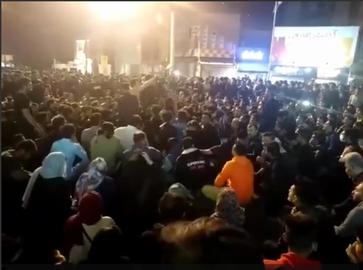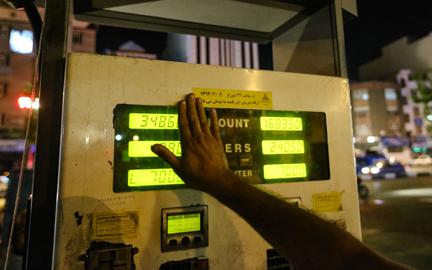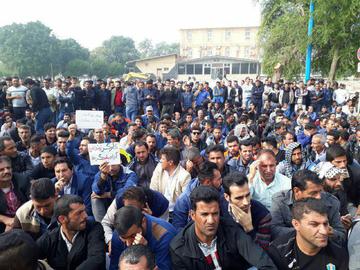Iranian officials have raised gas prices in Iran, prompting widespread protests across the country — unrest that is expected to spread.
In addition to the price hike, which was announced at midnight on November 15, officials introduced a rationing system for purchasing gas. In some cases, the price was raised by three times the previous price, and constituted a much higher increase than the last time prices were raised.
Official Iranian news agencies flashed the headlines: “Gas prices set: 1,500 tomans with ration coupons, 3,000 tomans without.”
Iranian government spokesman Ali Rabiei described the decision as "sad but necessary,” and officials said the measure was taken to help some of the country’s most vulnerable people.
Protests soon broke out across the country, including in the cities of Zahedan, Mashhad, Shiraz, Sirjan, and Ahvaz. Police were deployed near gas stations in several locations, and clashes broke out between protesters and police, with people shouting anti-government slogans in Mashhad, Iran’s second-largest city. In Shiraz, people lit fires around gas stations, whereas protesters in other cities attacked gas stations and blocked access to streets.
Authorities have routinely chosen Friday, the Muslim holy day, to make controversial announcements in a bid to buy time before the inevitable public backlash, but following the recent announcement, Iranian citizens went out on the streets to demonstrate nonetheless.
The Supreme Council of Economic Coordination was said to be behind the decision. The council is made up of the heads of the three branches of government and was only set up a few months ago by the Supreme Leader Ayatollah Khamenei. It gives the power to make the country’s most vital economic decisions to four people — the three heads of the branches plus Khamenei — and bypasses the parliament, the cabinet and other decision-making bodies.
Only a few governments around the world fix their countries’ gas prices, and Iran is one of them. Setting gas prices is a complicated matter on economic, social, and political grounds. Authorities in Iran essentially regard it as a matter of national security, and when they prepare to change the prices, it’s often top secret in order to prevent unrest and stunt the planning of protests.
How Much has the Price of Gas Increased?
Effective as of Friday, November 15, gas will be sold at two prices: 1,500 tomans (13 cents, 1.5 times the previous price) per liter with ration coupons and 2,000 tomans (17 cents, three times the previous price) without coupons.
Protests also broke out the last time gas prices were increased, on April 24, 2014. Then the price of a liter of gas in the open market went from 700 tomans to 1,000 tomans, an increase of 42 percent. Taking inflation into account, the value of 1,000 tomans in April 2014 (31 cents) was over 2,320 tomans in today’s Iranian currency. In other words, the recent increase in gas prices is much steeper than the last time.
In 2014, President Rouhani’s first administration increased gas prices, a confident decision taken after relatively careful deliberations. There is little evidence that such careful planning was taken in this most recent decision, and people’s hope for economic improvements are far less high than they were in 2014. The current economic, social and political conditions in Iran are so volatile and devastating that even Iranian officials concede the crisis is unprecedented over the last 40 years. Although officials argued the decision to raise prices was necessary given the current economic climate, the levels of discontent are profound and will not come as a surprise.
Why the Price Increase?
On paper, Iranian economists, regardless of their ideological leanings, agree that affordable gas essentially amounts to a waste of national resources, and that low-income and vulnerable Iranians will be the first to suffer from gas being sold at a rock-bottom price, as essentially it will do nothing to boost Iran’s economy. The government’s financial resources have been depleted to such a degree that it has had difficulty paying the salaries and benefits of its employees and retirees’ pensions. In such a situation, fuel subsidies are an unnecessary burden on the public treasury and it is the rich who benefit more from these subsidies. According to calculations by Iran’s Planning and Budget Organization, the tenth decile of Iranians, meaning the rich, benefit 23 times more from these subsidies than the first decile, i.e., the very poor.
So why has the council taken this decision now, when the country is undergoing such a heavy crisis and people are at breaking point?
An Arbitrary Rise?
Whether experts or ordinary citizens, very few people believe the decision was taken in a prudent or correct manner. It is not clear on what basis the new prices and the rations were set. Why has the price of gas in the open market been set at 3,000 tomans and not, for example, 2,800 or 3,200 tomans? Does it have anything to do with the Persian Gulf’s FOB (“Free on Board”) prices? If so, what will happen if these FOB prices go down, or up? Or has the decision been based on production costs, which are also certain to either rise or fall?
Inflationary Shock on the Way?
According to several economic studies, an increase in the price of fuel affects the prices of goods and services as well. Some of this increase will be due to the rise in transportation costs that. Until now, fuel suffered least from inflation compared to other commodities and services in Iran. Add to this the psychological shock to an already unbalanced market, and this shock could lead to devastating consequences for the Iranian economy and its people.
Data available on inflation reveals that inflation usually rises following price rises in gas. This depends on the rate of the increase and the general conditions of the economy — in Iran at the moment, both are a cause for worry. In October, before the increase in gas prices, the inflation rate was over 40 percent and now, with the increase, it is very likely that inflation will spike again.
A report published by IranWire in May 2019, when talk of increasing gas prices started, showed that price increases and inflation have followed an essentially fixed pattern over the last 12 years [Persian link]. With today’s announcement, the pattern continues, but this time with an even more accelerated and devastating effect.
Related Coverage:
How Corruption is Gnawing Iran from Within, November 14, 2019
Iran Breaks Misery Index Records Among Nations, November 6, 2019
The Misery Map of Iranian Provinces, November 6, 2019
Iran’s Shrinking Economy, October 21, 2019
Iran Joins Eurasian Economic Union to Combat US Sanctions, October 14, 2019
Employment Figures for Summer 2019: Has it Really Improved?, October 11, 2019
Is There any Hope of Reining in Iran's Runaway Inflation?, May 24, 2019
This Year 57 Million Iranians Will Be Living Below the Poverty Line, May 15, 2019
A Bleak Future for Iran's Job Market, May 3, 2019
Decline in Investment Across Iran After US Exit from the Nuclear Deal, April 27, 2019
Can Iran Survive Record Inflation?, February 25, 2019
Iran’s Unemployment Crisis: Only 11 Million Full-time Jobs, January 23, 2019
visit the accountability section
In this section of Iran Wire, you can contact the officials and launch your campaign for various problems



























comments